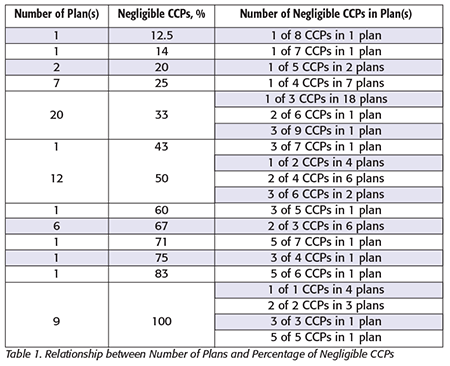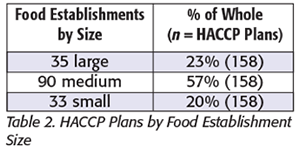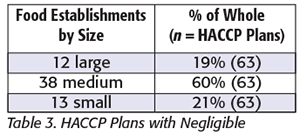The Critical Control Points (CCPs) in Fish and Fishery Product Hazard Analysis and Critical Control Points (Seafood HACCP) plans from 158 Florida wholesale seafood establishments were evaluated for food hazard significance, probability and likelihood to occur within the food establishment’s process, end product and intended consumer use. The plans were obtained from on-site, rated inspections from October 1, 2014, to September 30, 2016, and carried out by the Florida Department of Agriculture and Consumer Services (FDACS) under contract to the U.S. Food and Drug Administration.
The study found that a substantial percentage of the CCPs, 105 of 440, or 23.9%, were not significant, probable or reasonably foreseeable food hazards within that given process and/or end product, nor were they required by 21 C.F.R. Part 123. These CCPs, termed “negligible elements” in the study, were found in 63 of the 158 plans (39.9%); in fact, 9 of those 63 plans (14.3%) did not include a single valid CCP. The study also found that these negligible elements were distributed among small, medium and large companies in proportion to the number of companies in those categories.
The study recommends further studies to determine whether the conclusions of this study might apply beyond Florida; whether negligible elements might be controlled by other means; the potential extent and cost of HACCP report bias due to negligible elements; opportunities to overcome the negligible element problem by training or outreach; and whether the problems found in Seafood HACCP plans might also occur in Preventive Controls for Human Food and food safety plans.
Background
Mandatory Seafood HACCP preventive measures have been in place for nearly 20 years in Florida. During this period, some seafood processors appear to have incorporated elements as CCPs that may not be significant, reasonably foreseeable and/or probable food hazards within the specific process and/or end product, termed “negligible elements” in this study. For example, anecdotal evidence suggests that some seafood establishments may be using their Seafood HACCP plan as a repository for a broad range of company, program and/or customer-specific rules that are related only in a minor way, if at all, to food safety in regard to the given process and end product. In other cases, differing end products and processes are included into one single HACCP plan, thus unnecessarily applying CCPs, monitoring and verification steps to an end product and/or a process where a food hazard may not be significant, reasonably foreseeable and/or likely. The continuing and perhaps growing use of Seafood HACCP plans as a catch-all location for company, customer and/or third-party specific information by including negligible elements could cloud the purpose of Seafood HACCP plans to the seafood establishment operator.
For regulators, the inclusion of negligible elements appears to have the potential to undermine the statistical validity of the Seafood HACCP system. For example, an unlikely food safety element as a CCP in an HACCP plan, an element not required by 21 C.F.R. Part 123, may be found in violation and thus count toward an HACCP violation but have nothing to do with HACCP. The continued use of these negligible elements may misstate the actual situation regarding Seafood HACCP violations in Florida and as a result divert resources from other food safety regulatory areas.
As a result of these concerns, the FDACS Division of Food Safety asked the following questions: What is the extent to which negligible elements are incorporated as CCPs in Florida Seafood HACCP plans? What is the distribution of required CCPs and negligible elements in seafood establishment HACCP plans? What is the percentage of negligible elements incorporated into Seafood HACCP plans? What percentage of food establishments incorporate negligible elements as CCPs that could be monitored as Sanitation Standard Operating Procedures? Is there any correlation between the inclusion of negligible elements in Seafood HACCP plans and the food establishment size?
Methodology
A total of 158 Seafood HACCP plans were used as the sample for this project. Those plans were evaluated for biological, chemical and physical potential hazards in relation to one end product and process using the information obtained at time of inspection (including inspector flow charts, inspector Hazard Analyses and the seafood establishment’s HACCP plan) and 21 C.F.R. Part 123, and the Fish and Fishery Products Hazards and Controls Guidance (fourth edition). Each CCP was then scored in regard to a food hazard that was reasonably foreseeable, significant and probable or as a negligible element within the specific process, end product and intended consumer use. The evaluation of these CCPs considered the specific end product package (air package or modified air packaging), process steps and time, product holding state (frozen or refrigerated) and the intended end consumer use (raw, cooked or further processed).
To test for the relationship between the inclusion of negligible elements and the size of the seafood establishment, the seafood establishments were assigned to 1 of 10 categories based on annual gross sales estimated by the establishment at the time of rated on-site inspection. Those categories were then broken into three groups: small ($0 to $499,999), medium ($500,000 to $9.9 million) and large ($10 million and up). The size categorization was used to test whether a firm’s size was associated with the likelihood of use of negligible elements.
Results
A total of 440 individual CCPs were identified and reviewed in the 158 HACCP plans evaluated. A total of 335 CCPs reviewed (76%) were reasonably foreseeable, significant and probable food hazards within the specific process, end product and/or intended customer use. However, 105 (23.9%) appeared to be negligible elements, that is, not required to be CCPs, in regard to the applicable process and end product.
 These 105 negligible element CCPs, not required by 21 C.F.R. Part 123, were found in 63 of the 158 HACCP plans (39%) evaluated. The percentage of CCPs not required in an HACCP plan ranged from 12.5% to 100% of the total CCPs in the food establishment’s plan. Table 1 presents the relationship between the percentage of negligible CCPs and the number of plans.
These 105 negligible element CCPs, not required by 21 C.F.R. Part 123, were found in 63 of the 158 HACCP plans (39%) evaluated. The percentage of CCPs not required in an HACCP plan ranged from 12.5% to 100% of the total CCPs in the food establishment’s plan. Table 1 presents the relationship between the percentage of negligible CCPs and the number of plans.
All CCPs in 9 of the 63 plans (14.3%) were negligible elements. In most of these cases, the seafood establishment (secondary receiver) received frozen product, did not further process or relabel, and shipped the frozen product back out, as with, for example, box-in, box-out products. In other words, the probability of significant food hazards occurring while in an unchanged frozen state is not reasonably foreseeable, and thus, any CCP is a negligible element.
Some examples of negligible elements included as CCPs in the HACCP plans reviewed:
• Metal inclusion — knives used with manual cutting of fish
• Cooling — rapidly cooling cooked seafood to safe temperatures within 2 hours
• Allergen labeling — within a single-ingredient fish end product
• Storage — product held in a frozen state
• Clostridium botulinum — for an end product air-packed
• Receiving — incoming product received in a frozen state
• Processing — histamine time control with brief processing steps
 Small seafood establishments made up 20% of the 158 plans examined in the study; medium-size seafood establishments constituted 57%; and 23% were large. Table 2 further illustrates the percentages of HACCP plans by food establishment size.
Small seafood establishments made up 20% of the 158 plans examined in the study; medium-size seafood establishments constituted 57%; and 23% were large. Table 2 further illustrates the percentages of HACCP plans by food establishment size.
 The size distribution was then applied to only those 63 seafood establishments with negligible elements, that is, CCPs not required by 21 C.F.R. Part 123. Table 3 shows HACCP plans grouped by food establishment size. These results were close to the size distribution of all 158 seafood establishments. There appears to be no correlation of seafood establishment size and the subsuming of negligible elements as CCPs into HACCP plans.
The size distribution was then applied to only those 63 seafood establishments with negligible elements, that is, CCPs not required by 21 C.F.R. Part 123. Table 3 shows HACCP plans grouped by food establishment size. These results were close to the size distribution of all 158 seafood establishments. There appears to be no correlation of seafood establishment size and the subsuming of negligible elements as CCPs into HACCP plans.
Conclusions
A substantial number of negligible elements were subsumed as CCPs in the sample of HACCP plans reviewed in this study. In fact, a total of 105 out of the 440 CCPs (23.9%) reviewed appear to be negligible elements, and 39% of the food establishment HACCP plans evaluated contained at least one negligible element included as a CCP but not required by 21 C.F.R. Part 123.
Further research is required to determine how the 105 negligible element CCPs could be better controlled by means other than inclusion in a Seafood HACCP plan.
In conclusion, there does not appear to be a correlation between food establishment size and the inclusion of negligible elements as CCPs in HACCP plans. In other words, seafood establishments from the smallest to the largest appear to be including negligible elements as CCPs in their HACCP plans.
Recommendations
A similar study should be carried out in one or more states with a large seafood industry to identify whether the conclusions here are particular only to Florida or may indicate a national pattern of subsuming negligible elements into Seafood HACCP plans.
Future research should examine how negligible elements in Seafood HACCP plans might be better controlled by other means and to what extent the inclusion of negligible elements biases inspection reports based on Seafood HACCP plans, as well as estimating the potential costs of that bias in terms of industry and regulatory resources. Such research might assess the potential detraction from the qualitative statistical approach of HACCP as well as unnecessary use of industry and regulatory resources on these lesser elements.
Further research should also examine opportunities to either identify existing Seafood HACCP training methods and focused outreach initiatives or develop methods and initiatives that might address the issues identified in this study. Additionally, it should examine whether the problem of negligible elements in Seafood HACCP might well be a problem in the future in Good Manufacturing Practices and Hazard Analysis and Risk-Based Preventive Controls for Human Food to incorporate changes into training methodology for industry and regulators.
The intention is to apply some of the above recommendations and take action in Florida: specifically, to focus outreach activities on those seafood processors that were identified during this research to have incorporated negligible elements as CCPs within their HACCP plans. Additionally, outreach initiatives to broach this subject with various seafood industry associations are already in the making.
I would like to acknowledge the following individuals and their respective agencies for their assistance during this study: First and foremost, Matt Colson, chief, Bureau of Food Inspection, at the FDACS, for his assistance with the FDACS Food Inspection Management System; Gabrielle Dehart, staff assistant, for her assistance in compiling and organizing the large number of individual documents in the study; Merrill Emfinger, formerly of FDACS, for his assistance in categorizing firm size; as well as Eugene Evans with New York Agriculture and Markets for being a never-ending sounding board and source of feedback. Finally, thanks to the International Food Protection Training Institute for the support of Dr. Paul Dezendorf, Cameron Smoak and Joe Corby throughout the project.
Matthew Coleman, CP-FS, RS, is the environmental administrator, manufactured food, at the FDACS. He can be contacted at MatthewColeman@FreshFromFlorida.com. This research was conducted as part of the International Food Protection Training Institute’s Fellowship in Food Protection, Cohort VI.
Resources
1. Current Good Manufacturing Practice, Hazard Analysis, and Risk-Based Preventive Controls for Human Food. 21 C.F.R. Section 117 (2016).
2. Fish and Fishery Products, 21 C.F.R. Section 123 (1995).
3. www.fda.gov/downloads/Food/GuidanceRegulation/UCM251970.pdf.




